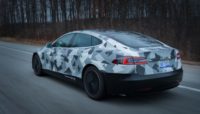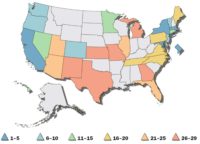STUTTGART, Germany—Mercedes-Benz’s experimental electric car, the Vision EQXX, broke its own efficiency record in June, travelling 747 miles from Stuttgart, Germany, to Silverstone, UK, on a single battery charge.
After departing Stuttgart, the Vision EQXX crossed the French border near Strasbourg, then cruised across northern France at highway speeds to Calais, where it boarded the Eurotunnel. Continuing its journey in the UK, it took the M25 around London then stopped off at Mercedes-Benz Grand Prix in Brackley.
The car then travelled to Silverstone, where Formula E driver Nyck de Vries put the vehicle to the test on the iconic British race track. Taking the vehicle up to its maximum speed limit of 87 mph, he completed 11 laps, using the last of the vehicle’s charge to negotiate pit lane.
Throughout the road trip, the Vision EQXX took advantage of its thermal management system to achieve an average consumption of 8.3 kilowatt-hours per 100 kilometers despite heavy traffic and summer temperatures.
The vehicle’s long-distance journey on public roads provided R&D experts with valuable data for EV development.
“The Vision EQXX has proven that it can easily cover more than 1,000 kilometers on a single battery charge [in] real- world conditions,” says Markus Schäfer, chief technology officer responsible for development and procurement at Mercedes.
The main challenges on the trip were summer temperatures of up to 86 F and heavy traffic around Stuttgart and southeast England. Nevertheless, the EV kept cool thanks to its thermal management system.
The efficiency of the electric drive unit means it generates only minimal waste heat. This helps keep the thermal management system small and lightweight. The carefully engineered interaction of aero-shutters, coolant valves and pumps ensures the electric drive unit maintains the most efficient temperature balance at minimum energy cost. It encompasses a combination of innovative air-flow management and a cooling plate installed in the vehicle floor, enabling it to take advantage of the air flowing along the underside of the vehicle. This is the most aerodynamically efficient way of keeping the electric drive unit cool under normal conditions, allowing an increase in range of around 2 percent in the most aerodynamic mode.
High ambient temperatures and stop-and-go highway traffic necessitated cooling of the electric drivetrain and passenger cabin. However, an on-demand cooling system handled the issues with no significant impact on range. The multi-source heat pump proved efficient at keeping the cabin temperature cool in the warm summer weather. During the 14 hours and 30 minutes of driving time, the air conditioning was operational for just over eight hours, yet had a minimal negative impact on overall energy consumption.


